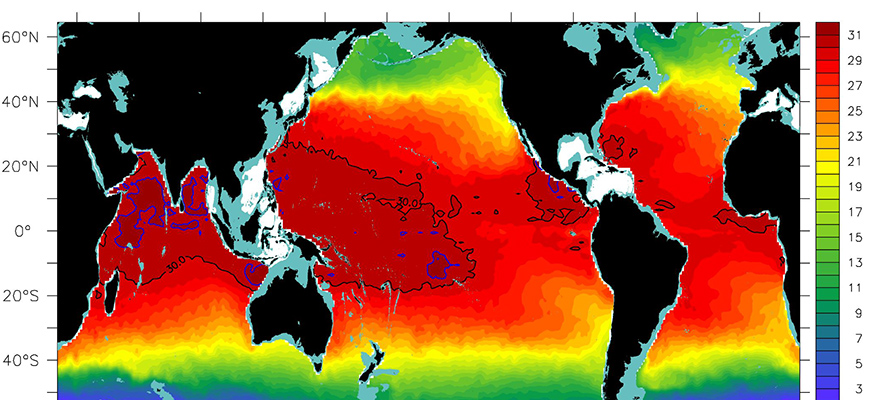Global S&T Development Trend Analysis Platform of Resources and Environment
| Voyager: Is there a limit to how much sea temperatures can rise? | |
| admin | |
| 2017-07-18 | |
| 发布年 | 2017 |
| 语种 | 英语 |
| 国家 | 美国 |
| 领域 | 资源环境 |
| 正文(英文) |  Monthly mean sea surface temperature maximums observed by Argo network 2004-2017 At the ocean surface, the ocean and atmosphere place a natural cap on water temperature thanks to convection, the force that causes strong vertical movement in the atmosphere and makes towering thunderstorms. As ocean temperature rises in a given region, convection pulls moisture upward into the atmosphere and builds clouds. Those clouds limit the sunlight that reaches the ocean surface and thus cool it. This process begins to take place when ocean surface temperatures reach 26° C (79° F) or so. Very small areas of water can get very hot for short periods of time but that doesn’t say much about the overall warmth of the ocean so let’s consider regional or larger scales and monthly averages. At the present time, the limit to which ocean surface temperatures can rise at those scales is estimated to be about 30° C (86° F), though monthly maximums in a few areas in the tropics have reached 31° C (88° F). Around the world, the temperature of the sea surface and overall average temperature of the ocean are rising because there is slightly more incoming solar radiation globally than there is outgoing heat radiation. That imbalance of heat energy results from greenhouse gas emissions caused primarily by human activities. More than 90 percent of that energy is stored in the oceans. Scientists consider the limit to 30° C under current climate conditions but as global temperatures continue to rise, the maximum possible temperature of the surface ocean might increase over time. Some scientists have projected that if current global warming trends continue, ocean temperatures could rise between 2° C (3.6° F) and 5° C (9° F) by 2100.
This story appears in explorations now, Scripps Institution of Oceanography's award-winning ocean and earth science magazine. Sign up to receive our free monthly story roundup.
|
| URL | 查看原文 |
| 来源平台 | Scripps Institution of Oceanography |
| 文献类型 | 新闻 |
| 条目标识符 | http://119.78.100.173/C666/handle/2XK7JSWQ/107545 |
| 专题 | 资源环境科学 |
| 推荐引用方式 GB/T 7714 | admin. Voyager: Is there a limit to how much sea temperatures can rise?. 2017. |
| 条目包含的文件 | 条目无相关文件。 | |||||
| 个性服务 |
| 推荐该条目 |
| 保存到收藏夹 |
| 查看访问统计 |
| 导出为Endnote文件 |
| 谷歌学术 |
| 谷歌学术中相似的文章 |
| [admin]的文章 |
| 百度学术 |
| 百度学术中相似的文章 |
| [admin]的文章 |
| 必应学术 |
| 必应学术中相似的文章 |
| [admin]的文章 |
| 相关权益政策 |
| 暂无数据 |
| 收藏/分享 |
除非特别说明,本系统中所有内容都受版权保护,并保留所有权利。
修改评论